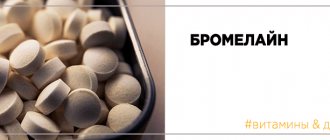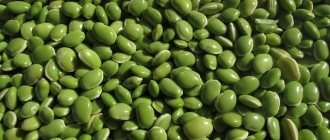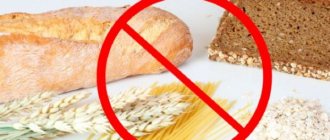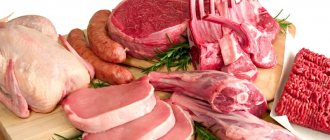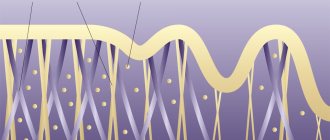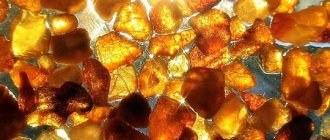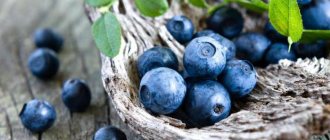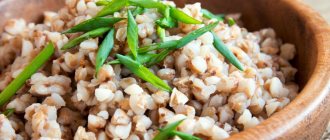What is fiber?
The question of which foods contain fiber does not arise by chance among people. When we talk about proteins, fats and carbohydrates, it becomes intuitively clear what we are talking about. We know what fats look like from everyday life. And the fact that carbohydrates should be contained in foods of plant origin is suggested by their very name.
With fiber the situation is different. Sometimes you can hear the synonymous expression “roughage”. But it does not give a definitive answer as to which foods contain fiber. Other names for this component of our diet are dietary fiber, as well as ballast substance (today this name is considered obsolete).
So, fiber refers to substances included in food that are not broken down by digestive enzymes, but are processed by intestinal microflora. As a rule, fiber is part of the cell membranes (walls) of plants and its structure consists of long and elastic bundles of fibers. This determines its mechanical properties and effect on the human body.
From a chemical point of view, fiber usually includes two large groups of dietary fiber:
- lingin;
- non-starch polysaccharides.
Non-starch polysaccharides, in turn, are also divided into two groups:
- cellulose;
- non-cellulosic polysaccharides.
Finally, non-cellulosic polysaccharides include:
- hemicelluloses;
- pectin substances;
- gum;
- mucus;
- storage polysaccharides like inulin and guar.
What are net carbs and fiber?
Net carbohydrates are carbohydrates that can be digested and processed by the body as dietary carbohydrate. Thus, they directly affect blood sugar levels. You can determine how many net carbohydrates you consume by subtracting the weight of fiber, glycerol, and sugar alcohols from the total weight of carbohydrates. If you're on a low-carb diet, then net carbs are the only carbs you need to count.
It's important to understand why fiber is not considered a regular carbohydrate. Fiber does not break down into sugar, so it does not play a role in the overall saturation of sugar from carbohydrates. If a piece of bread has 27 grams of total carbohydrates and 3 grams of fiber, then the net carbohydrate content will be 24 grams (27g – 3g = 24g). This explains why certain high-fiber foods will have a more beneficial effect on blood sugar and insulin levels.
Only plant foods contain dietary fiber. Fiber has certain effects on digestion, some beneficial and some more harmful. One positive effect is that fiber slows down the rate at which food is digested. This leads to a more gradual transition of food from the stomach to the small intestine. This means there is less chance of large amounts of glucose being absorbed from the small intestine into the blood, and therefore less chance of insulin levels rising. Insulin is a hormone that is released when glucose is absorbed in the small intestine. It is possible that by slowing gastric emptying, fiber helps avoid a situation in which the body must produce large amounts of insulin as a result of the frequent and rapid release of glucose in the intestines. In turn, this may protect people prone to diabetes.
However, fiber absorbs some nutrients. For example, up to 5% fat in a moderately high fiber diet is not absorbed due to this interference. High fiber foods also interfere to some extent with the absorption of some essential minerals and trace elements, but they also provide you with additional minerals and trace elements, so the impact is not significant.
Despite these minor negative effects, high fiber intake is considered much more beneficial overall. Low intake of fiber, especially the insoluble form found in bread and other wheat products, is one of the main causes of constipation. Low fiber intake is also strongly associated with an increased risk of diverticulitis. Although the evidence is less conclusive, lack of fiber in the diet may also contribute to colorectal cancer, hemorrhoids, obesity, appendicitis and ulcerative colitis. High intakes of soluble fiber, such as pectins and gums found in fruits, vegetables, oatmeal, and saponins from legumes, are associated with lower blood cholesterol levels. High consumption of plant-based foods that contain fiber is associated with a reduced risk of cardiovascular disease, cancer and increased life expectancy.
Another benefit, and one that may help with weight control, is feeling fuller when eating plenty of fiber. It's also true that foods high in fiber are almost always low in fat.
List of foods that contain fiber
As we have already found out, fiber is present in foods of plant origin, but its content varies significantly.
The fiber structure is partially destroyed when cereal is ground into flour, although some of it is preserved. But remember that flour and flour products made from it are not the same thing. Therefore, we do not recommend that you eat belyashi or fried pies to enrich your body with fiber.
Which foods contain more fiber? The main sources of dietary fiber are:
- grain and legume products;
- vegetables and herbs;
- berries, fruits and dried fruits;
- nuts and seeds.
For your convenience, we have compiled the most complete table, which indicates which foods contain fiber, as well as its mass fraction, percentage of the daily value (for the average adult male) and calorie content of this food product. To make it easier to find the item you need, we have divided the table into four parts, according to the types of products.
What foods contain soluble and insoluble fiber?
However, knowing the fiber content of a product is not enough. Dietary fibers vary in their physical and chemical properties. Accordingly, their effect on the human body also differs.
Insoluble fibers are represented by lignin and cellulose. Lignin has the property of binding bile acids. Thanks to it, cholesterol levels in the circulatory system are reduced. It also protects the gallbladder from stone formation. Cellulose accelerates the movement of food debris through the gastrointestinal tract.
When insoluble fiber enters our body with food, it plays the role of a kind of sponge that cleanses the walls of the gastrointestinal tract. With its deficiency, toxic substances accumulate in the intestines, and the population of pathogenic bacteria also increases, the waste products of which cause harm to the body.
Soluble dietary fiber does not form a “sponge”, but a “jelly”. In addition to their main role, improving intestinal motility, they interfere with the proliferation of putrefactive bacteria, thereby improving the condition of the microflora.
Some of the products listed in the tables above contain both soluble and insoluble fiber, while some contain only one of its types.
How does fiber work?
Fiber is a part of food that is not digestible by the body and is most often found in conjunction with carbohydrates. Well-known dietary fibers include cellulose, hemicellulose, pectins, beta-glucans, fructans and gums.
Dietary fiber can be soluble or insoluble. Legumes, oat bran, avocados and berries are sources of soluble fiber. Whole grains, wheat germ, flax seeds, leafy vegetables and nuts provide insoluble dietary fiber.
Dietary fiber can also be divided into fermentable and non-fermentable. The bacteria that inhabit the large intestine are able to ferment some undigested fiber and convert it into energy sources. Soluble fibers are more fermentable than insoluble fibers.
How does fiber work? Reduces the palatability of foods and thereby helps reduce the amount of food eaten. Soluble fiber absorbs water and turns into a gel that continues to swell, filling your stomach and making you feel full.
After eating a fiber-rich meal, blood glucose and insulin levels rise very slowly and gradually. The large intestine increases the volume of stool, which can lead to more calories being excreted from the body.
In other words, fiber helps reduce the amount of food you eat, slows down the process of food absorption in the stomach and small intestine, and then helps quickly remove undigested waste from the body.
Over the centuries, the amount of dietary fiber consumed has steadily declined. During Paleolithic times, people ate between 77 and 120 grams of dietary fiber per day. The traditional diet of different nationalities contains approximately 50 g of fiber per day. By comparison, the modern American diet contains only 15 grams of dietary fiber per day. The Dietary Guidelines for American Adults, edited by the Society of Cardiology, recommends 25 to 30 grams of fiber in your diet.
Dishes rich in fiber
And now a little digression for gourmets. Those who are not interested in eating just vegetables, fruits and cereals can pay attention to some dishes that retain as much fiber as possible, which is part of its ingredients.
- Vegetable salads based on arugula. Arugula has become especially popular in our country in the last 10–15 years. This herb goes well with non-cooked vegetables. Cherry tomatoes, pomegranate, onions, walnuts, and a dressing based on lemon juice, olive oil or vinegar are ideal ingredients for a fiber-rich salad. Pieces of blue cheese or chicken will enrich the taste and add satiety to the dish.
- Fruit and vegetable smoothies. For those who lead a healthy lifestyle, smoothies have long become an everyday drink. Among the fruits from which this drink is traditionally made, kiwi is the richest in fiber, and among the more exotic ingredients is feijoa.
- What about hot dishes? Of course, the fiber content in them will obviously be lower, but still some of them noticeably stand out for the better in this indicator. For example, stuffed peppers, stewed or baked. Especially if you use more vegetable ingredients when making minced meat: tomatoes, onions, garlic, spinach, zucchini and basil. By the way, vegetarians say that even without meat, such minced meat will turn out very tasty!
How to take fiber correctly for weight loss
To achieve the desired result, it is important to follow certain rules. The main nutritional nuances are:
- Consult your doctor or nutritionist first.
- Eat food at least 4-5 times a day.
- For breakfast, try to eat porridge. In the morning this dish will be well digested.
- Chew your food thoroughly.
- Follow the drinking regime: daily volume – 1-2 liters. Between meals, drink clean water without additives or gas.
- Remember that the menu is based on fiber-rich foods.
- Do not have a late dinner: the last meal is no later than 19:00. Fiber is consumed at night in the form of fruits, stewed vegetables, boiled lean meat, and fish.
- Use fresh produce according to seasonality: for example, do not buy cucumbers and tomatoes in winter, because at this time these products do not contain the required amount of vitamins and fiber.
- Sources of fiber in the diet are fermented milk products, green vegetables, fruits, herbs, cereals, bran.
- Boil, stew, bake, grill food: use a slow cooker, a double boiler.
- Pay special attention to preparing breakfast. It should be nutritious and light.
- Do not consume smoked, sugar, fried, too fatty foods, fast foods, alcohol. Avoid “bad” carbohydrates: pastries, cakes, pastries, chips, white bread.
- If you really want something sweet, then eat dried fruits.
- Stop smoking.
- Play sports regularly and do physical exercises.
- Maintain a sleep schedule. This will help maintain health, good mood, and improve the immune system.
Why else do you need fiber?
Most people know that the need for fiber is related to normal digestion. Many people are looking for: what foods contain fiber for weight loss. Of course, its functions do not end there. After reviewing the list of products, let’s figure out what functions food rich in fiber actually performs.
- Purgation. As we have already noted, fiber acts as a sponge that removes all unnecessary substances from the intestinal walls.
- Microflora balance. Fiber maintains a level of acidity that is favorable for the development of beneficial bacteria and hostile to parasitic bacteria.
- Reducing cholesterol and blood sugar levels. As a result, the body requires less insulin, which means fiber helps fight fat deposits and promotes weight loss. Diets based on foods rich in fiber are used to prevent and treat diabetes and obesity.
- Removing excess estrogen. Excess of female sex hormones is dangerous to health and can even lead to the development of tumors. Plant fibers help remove estrogens from the female body in a timely manner.
- Preventing the formation of gallstones.
- Reducing the risk of cardiovascular diseases. Obviously, the above points lead to a reduction in the load on the heart.
- Prevention of atherosclerosis.
How to distinguish between healthy and unhealthy carbohydrates
Refined carbohydrates, such as white sugar and white flour, raise insulin levels more than any other food. Insulin and insulin resistance cause obesity. Refined carbohydrates make you fat, but this does not mean that absolutely all carbohydrates make you fat.
“Healthy” carbohydrates (whole fruits and vegetables) differ significantly from “bad” carbohydrates (sugar and flour). You can eat broccoli in any quantity, and it will not make you gain weight. But even moderate amounts of sugar undoubtedly cause excess weight. However, these are all carbohydrates. How do we distinguish some carbohydrates from others?
Dr. David Jenkins from the University of Toronto in 1981 proposed to understand this issue using the glycemic index. He looked at foods based on their ability to raise blood glucose levels. Since dietary protein and fats do not affect the concentration of glucose in the blood, they were excluded from the glycemic index. Only foods containing carbohydrates remained.
The glycemic index is calculated from a 50 g serving of carbohydrates. For example, if you take carrots, watermelon, apples, bread, pancakes, a candy bar and oatmeal, then you need to separate a portion of each product that will contain 50 g of carbohydrates and evaluate its effect on blood glucose levels. Then it is necessary to compare the results obtained with the reference standard - glucose, whose glycemic index is 100 units.
As a result, there will be a huge difference between refined and unrefined carbohydrates. Western refined foods have a high glycemic index. Traditional whole foods are low. It turns out that carbohydrates acquire harmful toxic properties after processing. How does this happen?
What is the norm for consuming foods rich in fiber?
The generally accepted average daily fiber intake for an adult is 30 grams. However, the need is specified depending on gender and age:
- women from 18 to 50 years old: 25 grams;
- women over 50 years old: 21 grams;
- men from 18 to 50 years old: 38 grams;
- men over 50 years old: 30 grams.
At first glance, it may seem that many of the products containing fiber and listed in our tables are consumed regularly in one way or another, and, therefore, dietary fiber should enter our body in abundance. For example, in most of the fruits we are familiar with (oranges, bananas, pears, apples, grapes), 100 grams of weight account for 5–7% of the daily fiber requirement. Simple arithmetic will refute our misconceptions. To fully satisfy the needs of our body, we need at least one and a half kilograms of fruit daily!
Do not forget also that fibers are destroyed during food processing. So, if grain wheat contains 10.8–11.3 grams of fiber per 100 grams of product, then 1st grade wheat flour already contains 4.9 grams. Under the influence of temperature, the fibers continue to break down. Therefore, it makes no sense to look for fiber in baked goods and baked goods. The only exception is bread with whole grains or bran. The same thing happens when preparing dishes from vegetables, herbs, legumes, and so on. Therefore, the actual situation is this: many people lack fiber in their daily diet. It is not surprising that today the popularity of drugs and dietary supplements containing plant fibers is growing.
General rules
A high-fiber diet is a type of low-calorie carbohydrate diet used to reduce body weight without causing crippling hunger.
What is fiber, and what properties of it allow people who practice a fiber diet to lose weight? Fiber (dietary fiber) is part of plant cells that are resistant to the effects of human gastrointestinal enzymes. In terms of chemical composition, it is a heterogeneous group of substances, including polysaccharides and lignin . Fiber includes pectins , protopectins , alginase , cellulose , hemicellulose , gum , chitin , phytin , alginates . At the same time, some of them (pectins, hemicellulose, alginase, gum) can dissolve and be partially broken down by intestinal microflora, while some (cellulose) do not dissolve in the body and are excreted almost unchanged. Sources of fiber in the diet are products of plant origin, and their content varies widely. The table below gives a general idea of its content in products.
| Food | Content of dietary fiber per 100 g of product |
| Bran | 44,0 |
| Legumes | 5-25,0 |
| Raw vegetables and fruits | 2,5-5,8 |
| Cereals (oatmeal, rice) | 8,1-15,5 |
| Nuts (peanuts, almonds) | 3,8-4,2 |
| Fresh garden herbs | 4,0 |
| Seeds | 2,1-4,5 |
It should be noted that the products contain not just one, but different types of fiber, although in different concentrations. Thus, cellulose is found in the largest quantities in green peas, cabbage (Brussels sprouts, cabbage and broccoli), bran, second-grade wheat flour, cucumber peels, apples, peppers (red and green), and carrots. Hemicellulose is present in unrefined cereals, Brussels sprouts, bran, and mustard shoots. Gum - in legumes, oats.
Pectin is found mainly in apples, citrus fruits, carrots, potatoes, dry peas, red and white cabbage, wild strawberries, and strawberries. drinks made from freshly squeezed fruits.
Lignin - in radishes, peas, bran, beans, cereals, eggplants, strawberries. Therefore, the diet should include a variety of plant foods in order to provide the body not only with the required amount of fiber, but also with its different types.
The fiber intake rate is 25-30 g/day. To lose weight, your fiber intake can be increased to 35-40 g per day. To increase your fiber intake, you need to include more whole, natural foods in your diet by reducing your intake of non-fiber foods.
Foods rich in fiber perform the following functions in the body:
- It is a source of water-soluble vitamins and macro/micronutrients for the body.
- Normalizes blood sugar and cholesterol levels.
- It causes a feeling of fullness faster and remains in the stomach for a relatively long time.
- Helps cleanse the body of waste and toxins .
- Supports intestinal microbiocenosis and prevents the development of dysbiosis .
The basic principles of creating a diet for a diet enriched with fiber are:
- Vegetables (raw/cooked) must be consumed simultaneously with protein (meat and fish) products. Increase the amount of fiber-containing foods gradually.
- It is recommended to add bran to fermented milk products, soups, cereals, jelly, and juices.
- Eat fruits as often as possible as a snack; eat them with the peel; when preparing juices and smoothies from them, use the whole fruit with the skin.
- Boil cereals and legumes in water and eat without additives or with vegetable side dishes.
- Drink a sufficient amount of free fluid (2.5 - 3.0 l/day).
- Monitor the energy value of the diet and its balance in basic nutrients, since foods containing fiber are low-calorie.
A diet based on foods containing fiber for weight loss is a relatively simple program that allows you to adjust your body weight in a relatively short period of time at a relatively low financial cost. There are many options for diets of this type, the main difference of which is the list of products that are allowed to be included in the diet along with foods containing fiber.
These can be diets based on porridges with the inclusion of vegetables (bell peppers, tomatoes, garden herbs, cucumbers) and fruits (apples, pears), a protein diet with a lot of foods containing fiber (vegetables/fruits), a strict diet containing fiber and kefir, for which pharmaceutical fiber is used and even your usual diet with some restrictions and the inclusion of a sufficient amount of fiber-rich foods.
A diet based on fiber and kefir is especially popular . In a gentle version of the diet, the daily diet includes foods containing animal protein (chicken breast, cottage cheese, lean fish, egg white) in the amount of 100-150 g; foods containing complex carbohydrates and fiber - brown rice, legumes, buckwheat, oatmeal, whole grain bread, nuts, seeds and vegetable oils (linseed, olive, walnut, sesame oil in the amount of 30-50 g).
The rest of the volume comes from various vegetables - raw, baked, boiled, stewed and fruits. If desired, you can use pharmaceutical fiber and add it to ready-made meals and drinks. As a free liquid, you can drink green/herbal tea, still mineral water, freshly prepared juices, and fermented milk products.
At the same time, it is necessary to completely exclude from the diet white wheat bread, fatty red meat, canned food, baked goods, white rice, hard-melted animal fats, sausages, sugar, margarine, sweets, flour, fried and smoked foods, cheeses, pasta, spices and seasonings, chocolate, alcoholic drinks.
The energy value of such a daily diet is on average 1800-2000 Kcal, which allows you to reduce body weight by 3-5 kg over the course of 1-2 weeks, and the absence of hunger makes the process of losing weight relatively comfortable.
For greater effectiveness, it is recommended to practice preliminary preparation of the body by eliminating smoked, fatty, fried foods, salt, sweets and alcohol from the diet for several days, expanding it with fermented milk products, vegetables/fruits.
There are different types of fiber
As we have already written, fiber refers to different types of dietary fiber found in various foods. Their action differs depending on the chemical composition and structure. Separately, we would like to draw your attention to a type of dietary fiber called inulin.
Inulin fiber promotes tissue repair in both the intestines and stomach. Having an enveloping effect, they cover the walls of the stomach and provide an anti-inflammatory effect. In medical practice, inulin is often prescribed as a prebiotic (a substance that stimulates the growth of intestinal microflora).
Interestingly, inulin fibers have a sweetish taste. Due to this, it is often used as a safe sweetener in the production of dietary foods.
In our daily food, this type of dietary fiber is found in some amount in onions and garlic. However, some medicinal plants can boast of significantly higher content:
By the way, elecampane is a plant that deserves special attention. The substances contained in its roots have an antibacterial and wound-healing effect. Therefore, taking elecampane and drugs based on it has the most beneficial effect on gastritis and stomach ulcers.
Other sources of fiber
In an effort to enrich their diet with fiber, many turn to various drugs and nutritional supplements. Contrary to the opinion of skeptics, this is a completely normal and justified practice - subject to two conditions:
- Are you confident in the composition of the drug;
- Are you confident in the drug’s production technology?
Let's sort it out point by point. As for the composition of the drug, it is highly desirable that it be created on the basis of natural ingredients, with minimal use of food chemicals. Otherwise, the desired benefit may actually result in additional stress on internal organs, primarily the liver.
Production technologies should be of no less interest to the consumer. Indeed, even natural ingredients, having undergone thermal and chemical treatment, lose their beneficial properties due to the destruction of the chemical compounds included in their composition.
Both the first and second requirements are met by the domestic drug Mesi-Vit Plus. The basis of this natural vitamin complex is the roots and rhizomes of the medicinal plant elecampane that we have already mentioned. In addition to the prebiotic, cleansing, anti-inflammatory and antibacterial effects discussed above, it stimulates the production of digestive enzymes, helping to effectively digest and absorb food. It is important that the drug does not contain third-party enzymes, but helps the human body produce its own, thereby avoiding the replacement effect.
The production of the drug is based on cryoprocessing technology. Instant freezing and grinding of raw materials allows you to preserve both the chemical composition and microstructure of dietary fiber.
Thanks to this, Mesi-Vit Plus is the optimal way to saturate your diet with fiber, ease the functioning of the digestive system and cleanse the gastrointestinal tract of toxic substances and pathogenic bacteria. By the way, the drug will be an excellent support for the digestive system if the diet is disrupted, for example, during a business trip, tourist trip or during the May holidays.
Try the optimal source of fiber for your body - the Mesi-Vit Plus vitamin complex
Author: Chernetsov M. A.
Reviewer: reflexologist Kurus A. N.
Bibliography
- Vasyuk V. L. Clinical and pathogenetic rationale for the use of galenic preparations of elecampane in patients with chronic gastroduodenitis combined with chronic non-lithiasis cholecystitis: dis. ...cand. honey. Sci. – Ivano-Frankivsk, Ivano-Frankivsk State. honey. Academy, 2002.
- Zelenskaya K. L. et al. Elecampane is an adaptogen and antihypoxant. – Tomsk: publishing house Tom. state ped. University, 2004.
- Zelenskaya K. L. et al. Analgesic effect of alcohol extracts from Inula helenium L. // Plant resources. – 2003. – T. 39. – No. 2. – P. 82–85.
- Kozyrenko Yu. V., Bakumov P. A. Pharmacodynamics of a drug containing inulin (Astrolin) in patients with type 2 diabetes mellitus // Materials of the 64th scientific-practical. Confusion of young scientists of VolSMU. – Volgograd, 2006 – pp. 163–164.
- Sokolov S. Ya., Zamotaev I. P. Handbook of medicinal plants (Phytotherapy). – M.: Medicine, 1990. – 464 p.
- Konishi T., Shimada Y., Nagao T., Okabe H., Konoshima T. Antiproliferative sesquiterpene lactones from the roots of Inula helenium // Biol. Pharm. Bull. – 2002. – Vol. 25, No. 10. – P. 1370–1372.
- Licht TR, Hansen M., Poulsen M., Dragsted LO Dietary carbohydrate source influences molecular fingerprints of the rat faecal microbiota // BMC Microbiol. – 2006. – 30 (6): 98.
